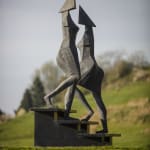Lynn Chadwick British, 1914-2003
Stairs (C126S), 1991
Bronze
239 x 160 x 112 cm
94 1/8 x 63 x 44 1/8 in
94 1/8 x 63 x 44 1/8 in
Edition 4 of 9
Further images
-
(View a larger image of thumbnail 1
)

-
(View a larger image of thumbnail 2
)

-
(View a larger image of thumbnail 3
)

-
(View a larger image of thumbnail 4
)

-
(View a larger image of thumbnail 5
)

-
(View a larger image of thumbnail 6
)

-
(View a larger image of thumbnail 7
)

-
(View a larger image of thumbnail 8
)

-
(View a larger image of thumbnail 9
)

This fantastic monumental ‘Stairs’ by Lynn Chadwick is the largest and most impressive work in the series of works of the same title that were first conceived in the 1990’s....
This fantastic monumental ‘Stairs’ by Lynn Chadwick is the largest and most impressive work in the series of works of the same title that were first conceived in the 1990’s. Movement had always been a key interest of Chadwick right from his first mobiles of the late 1940’s and early 50’s through to his dancing and walking figures. Towards the end of his career figures expressed movement in sculptures such as ‘High Wind’ and ‘Stairs’ as well as abstract shapes in kinetic movement such as ‘Ace of Diamonds’. In ‘Stairs’ we see two female figures passing each other on a set of simple stairs. Do they exchange a greeting, where are they walking to? Chadwick leaves the narrative to be interpreted by his viewer.
Lynn Chadwick came to sculpture through unconventional means initially working as an architectural draughtsman. He began his sculptural career making mobile constructions for building trade fairs and it was the resulting success of these early mobiles and stabiles two of which were shown on the South Bank during the Festival of Britain in 1951, that first allowed him to seriously consider becoming a freelance sculptor.
Chadwick’s unique approach was based on construction rather than modelling. First, he welded a linear armature or skeleton onto which he applied a skin, building up the surface to a solid form. By beginning with an abstract form or ‘space frame’ and investing it with an allusive vitality Chadwick’s working process is the reverse of most traditional approaches. The results are equally as original and each work has a carefully considered ‘attitude’ communicated through stance, texture and finish. Speaking of the process of making art Chadwick noted:
It seems to me that art must be the manifestation of some vital force coming from the dark, caught by the imagination and translated by the artist’s ability and skill… whatever the final stage, the force behind it is… indivisible.
Chadwick first came to international prominence in 1952 when he was included in the British Council’s 'New Aspects of British Sculpture' exhibition for the XXVI Venice Biennale alongside Kenneth Armitage, Reg Butler, Bernard Meadows, Geoffrey Clarke, Robert Adam, William Turnbull and Eduardo Paolozzi. The following year he was one of the twelve semi-finalists for the Unknown Political Prisoner International Sculpture Competition and went on to win the International Prize for sculpture at the 1956 Venice Biennale, beating Giacometti. Many honours and awards followed this period and his work was widely collected both privately and by major institutions globally. In 1964, he was awarded a CBE and in 2001 was elected a Royal Academician. A major retrospective of his work was held at Tate Britain, London in 2003.
Lynn Chadwick came to sculpture through unconventional means initially working as an architectural draughtsman. He began his sculptural career making mobile constructions for building trade fairs and it was the resulting success of these early mobiles and stabiles two of which were shown on the South Bank during the Festival of Britain in 1951, that first allowed him to seriously consider becoming a freelance sculptor.
Chadwick’s unique approach was based on construction rather than modelling. First, he welded a linear armature or skeleton onto which he applied a skin, building up the surface to a solid form. By beginning with an abstract form or ‘space frame’ and investing it with an allusive vitality Chadwick’s working process is the reverse of most traditional approaches. The results are equally as original and each work has a carefully considered ‘attitude’ communicated through stance, texture and finish. Speaking of the process of making art Chadwick noted:
It seems to me that art must be the manifestation of some vital force coming from the dark, caught by the imagination and translated by the artist’s ability and skill… whatever the final stage, the force behind it is… indivisible.
Chadwick first came to international prominence in 1952 when he was included in the British Council’s 'New Aspects of British Sculpture' exhibition for the XXVI Venice Biennale alongside Kenneth Armitage, Reg Butler, Bernard Meadows, Geoffrey Clarke, Robert Adam, William Turnbull and Eduardo Paolozzi. The following year he was one of the twelve semi-finalists for the Unknown Political Prisoner International Sculpture Competition and went on to win the International Prize for sculpture at the 1956 Venice Biennale, beating Giacometti. Many honours and awards followed this period and his work was widely collected both privately and by major institutions globally. In 1964, he was awarded a CBE and in 2001 was elected a Royal Academician. A major retrospective of his work was held at Tate Britain, London in 2003.
Provenance
From the artist's estateLiterature
Lynn Chadwick: Sculptor, Eva Chadwick & Denis Farr, Lund Humphries, Cat No: C126SJoin our mailing list
* denotes required fields
We will process the personal data you have supplied in accordance with our privacy policy (available on request). You can unsubscribe or change your preferences at any time by clicking the link in our emails.








